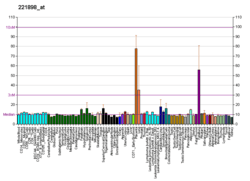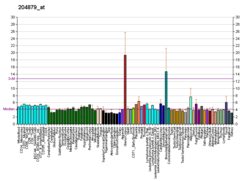PDPN
Podoplanin is a protein that is encoded by the "PDPN" gene in humans and animals.[4][5][6]
Structure and function
Podoplanin is a mucin-type protein with a mass of 36- to 43-kDa. It is relatively well conserved between species, with homologues in humans, mice, rats, dogs and hamsters.[7]
This gene encodes a type-I, integral membrane, heavily O-glycosylated glycoprotein with diverse distribution in human tissues. The physiological function of this protein may be related to its mucin-type character. The homologous protein in other species has been described as a differentiation antigen and influenza-virus receptor. The specific function of this protein has not been determined but it has been proposed as a marker of lung injury. Alternatively spliced transcript variants encoding different isoforms have been identified.[6]
This protein has been found to have functions in lung alveolar cells, kidney podocytes, and lymphatic endothelial cells. More recently, this protein has been found in neural tissue in both mouse and human samples.[8]
In lymphatic endothelial cells, experimentation has indicated that podoplanin plays a role in proper formation of linkages between the cardiovascular system and the lymphatic systems, typically causing fatty liver disease in these mice.[8]
Although the exact function is unknown in many tissues, podoplanin is generally receptive to detection via immunofluorescent staining and has been shown to co-localize with the protein nestin, a type VI intermediate filament protein expressed almost primarily in neural tissues.[9] Currently, the only protein known to interact with podoplanin physiologically is CLEC-2, a C-type lectin 2 expressed on platelets and on hematopoietic cells.[10] Both serve a role in the proper formation of blood/lymphatic connections in embryonic development.
Clinical significance
PDPN has been studied extensively in the cancer field. It is a specific lymphatic vessel marker, and since lymphangiogenesis levels are correlated with poor prognosis in cancer patients, it can be used as a diagnostic marker.[7] It is often upregulated in certain types of cancer, including several types of squamous cell carcinomas, malignant mesothelioma and brain tumors.[7] Moreover, it can be upregulated by cancer-associated fibroblasts (CAFs) in the tumor stroma,[7][11] where it has been associated with poor prognosis.[12]
In squamous cell carcinomas, PDPN is believed to play a key role in the cancer cell invasiveness by controlling invadopodia, and thus mediating efficient ECM degradation.[13]
References
- 1 2 3 GRCh38: Ensembl release 89: ENSG00000162493 - Ensembl, May 2017
- ↑ "Human PubMed Reference:".
- ↑ "Mouse PubMed Reference:".
- ↑ Zimmer G, Oeffner F, Von Messling V, Tschernig T, Groness HJ, Klenk HD, Herrler G (Sep 1999). "Cloning and characterization of gp36, a human mucin-type glycoprotein preferentially expressed in vascular endothelium". Biochem J. 341 (Pt 2): 277–84. doi:10.1042/0264-6021:3410277. PMC 1220357. PMID 10393083.
- ↑ Ma T, Yang B, Matthay MA, Verkman AS (Jul 1998). "Evidence against a role of mouse, rat, and two cloned human t1alpha isoforms as a water channel or a regulator of aquaporin-type water channels". Am J Respir Cell Mol Biol. 19 (1): 143–9. doi:10.1165/ajrcmb.19.1.2953. PMID 9651190.
- 1 2 "Entrez Gene: PDPN podoplanin".
- 1 2 3 4 Astarita, JL; Acton, SE; Turley, SJ (2012). "Podoplanin: emerging functions in development, the immune system, and cancer". Frontiers in Immunology. 3: 283. doi:10.3389/fimmu.2012.00283. PMC 3439854. PMID 22988448.
- 1 2 Fu J, Gerhardt H, McDaniel JM, Xia B, Liu X, Ivanciu L, Ny A, Hermans K, Silasi-Mansat R, McGee S, Nye E, Ju T, Ramirez MI, Carmeliet P, Cummings RD, Lupu F, Xia L (November 2008). "Endothelial cell O-glycan deficiency causes blood/lymphatic misconnections and consequent fatty liver disease in mice". J. Clin. Invest. 118 (11): 3725–37. doi:10.1172/JCI36077. PMC 2567837. PMID 18924607.
- ↑ Imaizumi Y, Amano I, Tsuruga E, Kojima H, Sawa Y (October 2010). "Immunohistochemical examination for the distribution of podoplanin-expressing cells in developing mouse molar tooth germs". Acta Histochem Cytochem. 43 (5): 115–21. doi:10.1267/ahc.10023. PMC 2965832. PMID 21060740.
- ↑ Herzog, BH; Fu, J; Wilson, SJ; Hess, PR; Sen, A; McDaniel, JM; Pan, Y; Sheng, M; Yago, T; Silasi-Mansat, R; McGee, S; May, F; Nieswandt, B; Morris, AJ; Lupu, F; Coughlin, SR; McEver, RP; Chen, H; Kahn, ML; Xia, L (3 October 2013). "Podoplanin maintains high endothelial venule integrity by interacting with platelet CLEC-2". Nature. 502 (7469): 105–9. doi:10.1038/nature12501. PMC 3791160. PMID 23995678.
- ↑ Kitano, H; Kageyama, S; Hewitt, SM; Hayashi, R; Doki, Y; Ozaki, Y; Fujino, S; Takikita, M; Kubo, H; Fukuoka, J (October 2010). "Podoplanin expression in cancerous stroma induces lymphangiogenesis and predicts lymphatic spread and patient survival". Archives of pathology & laboratory medicine. 134 (10): 1520–7. doi:10.1043/2009-0114-OA.1. PMID 20923309.
- ↑ Chuang, WY; Yeh, CJ; Chao, YK; Liu, YH; Chang, YS; Tseng, CK; Chang, HK; Wan, YL; Hsueh, C (2014). "Concordant podoplanin expression in cancer-associated fibroblasts and tumor cells is an adverse prognostic factor in esophageal squamous cell carcinoma". International Journal of Clinical and Experimental Pathology. 7 (8): 4847–56. PMC 4152045. PMID 25197355.
- ↑ Martín-Villar, E; Borda-d'Agua, B; Carrasco-Ramirez, P; Renart, J; Parsons, M; Quintanilla, M; Jones, GE (20 August 2015). "Podoplanin mediates ECM degradation by squamous carcinoma cells through control of invadopodia stability". Oncogene. 34 (34): 4531–44. doi:10.1038/onc.2014.388. PMC 4430312. PMID 25486435.
Further reading
- Wicki A, Christofori G (2007). "The potential role of podoplanin in tumour invasion". Br. J. Cancer. 96 (1): 1–5. doi:10.1038/sj.bjc.6603518. PMC 2360213. PMID 17179989.
- Robertson NG, Khetarpal U, Gutiérrez-Espeleta GA, et al. (1995). "Isolation of novel and known genes from a human fetal cochlear cDNA library using subtractive hybridization and differential screening". Genomics. 23 (1): 42–50. doi:10.1006/geno.1994.1457. PMID 7829101.
- Cross SH, Charlton JA, Nan X, Bird AP (1994). "Purification of CpG islands using a methylated DNA binding column". Nat. Genet. 6 (3): 236–44. doi:10.1038/ng0394-236. PMID 8012384.
- Bonaldo MF, Lennon G, Soares MB (1997). "Normalization and subtraction: two approaches to facilitate gene discovery". Genome Res. 6 (9): 791–806. doi:10.1101/gr.6.9.791. PMID 8889548.
- Strausberg RL, Feingold EA, Grouse LH, et al. (2003). "Generation and initial analysis of more than 15,000 full-length human and mouse cDNA sequences". Proc. Natl. Acad. Sci. U.S.A. 99 (26): 16899–903. doi:10.1073/pnas.242603899. PMC 139241. PMID 12477932.
- Kato Y, Fujita N, Kunita A, et al. (2004). "Molecular identification of Aggrus/T1alpha as a platelet aggregation-inducing factor expressed in colorectal tumors". J. Biol. Chem. 278 (51): 51599–605. doi:10.1074/jbc.M309935200. PMID 14522983.
- Kaneko M, Kato Y, Kunita A, et al. (2004). "Functional sialylated O-glycan to platelet aggregation on Aggrus (T1alpha/Podoplanin) molecules expressed in Chinese hamster ovary cells". J. Biol. Chem. 279 (37): 38838–43. doi:10.1074/jbc.M407210200. PMID 15231832.
- Gerhard DS, Wagner L, Feingold EA, et al. (2004). "The Status, Quality, and Expansion of the NIH Full-Length cDNA Project: The Mammalian Gene Collection (MGC)". Genome Res. 14 (10B): 2121–7. doi:10.1101/gr.2596504. PMC 528928. PMID 15489334.
- Martín-Villar E, Scholl FG, Gamallo C, et al. (2005). "Characterization of human PA2.26 antigen (T1alpha-2, podoplanin), a small membrane mucin induced in oral squamous cell carcinomas". Int. J. Cancer. 113 (6): 899–910. doi:10.1002/ijc.20656. PMID 15515019.
- Schacht V, Dadras SS, Johnson LA, et al. (2005). "Up-Regulation of the Lymphatic Marker Podoplanin, a Mucin-Type Transmembrane Glycoprotein, in Human Squamous Cell Carcinomas and Germ Cell Tumors". Am. J. Pathol. 166 (3): 913–21. doi:10.1016/S0002-9440(10)62311-5. PMC 1602360. PMID 15743802.
- Otsuki T, Ota T, Nishikawa T, et al. (2007). "Signal sequence and keyword trap in silico for selection of full-length human cDNAs encoding secretion or membrane proteins from oligo-capped cDNA libraries". DNA Res. 12 (2): 117–26. doi:10.1093/dnares/12.2.117. PMID 16303743.
- Hultgård-Ekwall AK, Mayerl C, Rubin K, et al. (2006). "An Interstitial Network of Podoplanin-Expressing Cells in the Human Endolymphatic Duct". J. Assoc. Res. Otolaryngol. 7 (1): 38–47. doi:10.1007/s10162-005-0021-8. PMC 2504586. PMID 16408168.
- Dumoff KL, Chu CS, Harris EE, et al. (2006). "Low podoplanin expression in pretreatment biopsy material predicts poor prognosis in advanced-stage squamous cell carcinoma of the uterine cervix treated by primary radiation". Mod. Pathol. 19 (5): 708–16. doi:10.1038/modpathol.3800580. PMID 16528371.
- Omachi T, Kawai Y, Mizuno R, et al. (2007). "Immunohistochemical demonstration of proliferating lymphatic vessels in colorectal carcinoma and its clinicopathological significance". Cancer Lett. 246 (1–2): 167–72. doi:10.1016/j.canlet.2006.02.013. PMID 16574316.
- Mishima K, Kato Y, Kaneko MK, et al. (2007). "Increased expression of podoplanin in malignant astrocytic tumors as a novel molecular marker of malignant progression". Acta Neuropathol. 111 (5): 483–8. doi:10.1007/s00401-006-0063-y. PMID 16596424.
- Wicki A, Lehembre F, Wick N, et al. (2006). "Tumor invasion in the absence of epithelial-mesenchymal transition: podoplanin-mediated remodeling of the actin cytoskeleton". Cancer Cell. 9 (4): 261–72. doi:10.1016/j.ccr.2006.03.010. PMID 16616332.
- Gregory SG, Barlow KF, McLay KE, et al. (2006). "The DNA sequence and biological annotation of human chromosome 1". Nature. 441 (7091): 315–21. doi:10.1038/nature04727. PMID 16710414.
- Mishima K, Kato Y, Kaneko MK, et al. (2007). "Podoplanin expression in primary central nervous system germ cell tumors: a useful histological marker for the diagnosis of germinoma". Acta Neuropathol. 111 (6): 563–8. doi:10.1007/s00401-006-0033-4. PMID 16718353.



